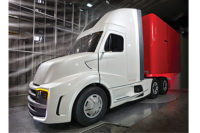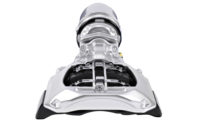Mid-America Trucking Show focuses on safety, efficiency
Trucking companies highlight telematics solutions














Not much is certain in today’s world, but two things can be counted on as winter releases its icy grip on Louisville, Ky. The first, and most important to the locals, is the March Madness surrounding the NCAA college basketball tournament. Although it doesn’t quite rise to the level of madness, the other reliable sign of spring in Louisville happens when 80,000 people and a ton of chrome fill the Kentucky Exposition Center for the annual Mid America Trucking Show (MATS), which took place March 27-29 this year.
As the trucking industry’s single largest event, it’s fairly common for the chief executive officers of exhibiting companies to report on recent performance and prognosticate about the year to come. Although everybody had a slightly different take on the numbers this time, the general consensus was that 2013 sales levels lived up to expectations and that 2014 is expected to be equal to or slightly better than 2013.
Although current sales represent a positive market for the manufacturers, they do not begin to represent enough volume to catch up for the loss in sales during the depths of the recent recession. As such, the average age of fleets now is in record-high territory, adding to a reservoir of pent-up demand for new trucks when the economy eventually recovers.
Having learned from getting caught on the wrong side of past boom and bust cycles, truck manufacturers will be unlikely to make significant capacity adjustments when the economic pendulum finally swings and the reservoir of demand is suddenly released. When that swing happens, it will tip the new-truck sales business heavily toward a seller’s market, so we’ll renew our advice to fleet operators not to be caught with a geriatric fleet when new truck order lead times stretch into 18 months or more.
As with last year, this year’s show was thin on new product announcements, focusing instead on refinements to existing products, with a particularly strong focus on safety and fuel economy. Here’s a look at the highlights from the show:
Bendix Expands SafetyDirect Capabilities
SafetyDirect, Elyria, Ohio-based Bendix Commercial Vehicles Systems LLC’s training and safety tool for drivers and fleet operators, has been updated with more customization options and quicker access to increasingly important video data. These improvements allow for more comprehensive application of the data generated by vehicle safety systems, enabling the creation of training programs that recognize ideal driving habits and target specific driver needs.
SafetyDirect is a user-friendly Web portal that provides fleet operators with videos of severe events, along with comprehensive feedback on their fleets and drivers. The system wirelessly and automatically transmits real-time driver performance data and event-based information to the fleet’s back office for analysis by fleet safety personnel.
“Safe drivers practicing safe driving habits, supported by comprehensive driver training, have always been the first line of defense in preventing accidents,” said Bendix Controls Group Marketing Director TJ Thomas, in a statement. “More than ever, SafetyDirect helps recognize and reinforce drivers’ best practices, enabling fleets to strategically enhance and improve their training programs to maximize safety.”
Using data from a vehicle’s safety systems, SafetyDirect captures and reports event-based occurrences in numerous preset categories, including excessive curve speed and excessive braking, and activates on-board safety systems, such as collision mitigation and stability events, to aid the distribution team.
The updated SafetyDirect now also offers a driver’s score card feature. Fleet operators can customize a weighted scoring system that assigns higher values to certain safety system activations, depending on their specific goals and needs. By multiplying those weights with the number of system activations in a given time period, SafetyDirect automatically generates reports that can help a fleet develop more targeted reward and training programs.
The benefit to drivers is that they can get needed training that focuses on areas that present them with the greatest challenges as well as opportunities to be rewarded for good driving behavior.
Around the clock, a severe event captured by SafetyDirect will trigger a notification, which is delivered to designated fleet personnel via a smartphone, tablet or email. These events are captured and stored with time and date indications, driver and vehicle identifications, an odometer reading, vehicle speed, and a GPS location. The system also provides real-time driver performance information such as following distance histograms and event counters for each driver. SafetyDirect turns all this data into clear, actionable information for fleet operators.
Severe event reports include a video clip taken from a windshield-mounted camera to provide definitive context. The event history extends 5 seconds before and after the event, improving a fleet manager’s ability to understand how and why it occurred. This ability to record video and integrate it with advanced data collection and translation is crucial to helping fleet managers quickly assess an event.
“We have seen cases where SafetyDirect video information has been instrumental in establishing that a driver was not at fault following an accident,” Thomas said in a statement. “So in addition to providing safety benefits, this wireless data supports effective, safe drivers and accelerates a fleet’s return on investment (ROI) in driver training and safety technologies.”
Because the ability to track trends often is as important as tracking severe events, SafetyDirect allows fleets to set thresholds for high and low performance, displaying each driver’s performance on a color-coded chart. This means fleet managers can determine trouble spots, such as excessive curve speeds, at a glance and take steps to resolve them. Fleet managers also can compare the performance of drivers and groups of drivers over time or monitor a particular driver’s performance in different trucks.
The following are Bendix safety systems that connect with SafetyDirect:
• Bendix ESP Electronic Stability Program
• Bendix Wingman Advanced Collision Mitigation Technology
• AutoVue Lane Departure Warning (LDW) System
• SmarTire Tire Pressure Monitoring System (TPMS)
• SmarTire Trailer-Link TPMS
SafetyDirect optimizes these safety technologies and accelerates the ROI on them through its data collection and reporting capabilities. SafetyDirect also can link to non-Bendix systems that provide J1939 vehicle data.
Powerful partnerships
Eaton Corp. plc, Dublin, and Cummins Westport Inc., Vancouver, announced an integrated powertrain package for the Cummins Westport ISX12 G natural gas engine that will provide fleets with the first automated transmission to be paired with a spark-ignited natural gas engine in the North American market. The powertrain will combine an Eaton UltraShift Plus automated transmission with the Cummins Westport ISX12 G engine.
With the interest in alternative fuels driving more fleets to integrate natural gas engines into their portfolios, this combination meets a growing market need while providing optimized powertrain integration.
The UltraShift Plus automated transmission offers maximum power capacity, superior acceleration and low-speed maneuverability. Paired with the Cummins Westport ISX12 G natural gas engine, the new powertrain package will be available for line-haul and regional-haul applications in mid-2014.
The Cummins Westport ISX12 G natural gas engine is based on the Cummins ISX12 diesel engine, but it operates on 100 percent natural gas in either compressed natural gas (CNG) or liquefied natural gas (LNG) forms. Ideally suited for regional haul applications, the ISX12 G has a robust power band at 1,500-1,800 revolutions per minute (RPM) and delivers excellent responsiveness, with peak torque at 1,200 RPM. This natural gas engine
is available with ratings of 320-400 horsepower and
1,450 pound-feet of torque.
The following benefits are listed for the integrated powertrain package:
• Intelligent shift selection software for performance and efficiency improvements
• Better launch and shift decisions through grade sensing, weight computation and driver throttle commands
• Hill Start Aid, which prevents rollbacks when engaged, reduces risk, and simplifies operations for even the most inexperienced drivers
• Tailored shift logic that enables efficient operation and enhances braking performance
Stability control
Western Star Trucks, Fort Mill, S.C., has announced that Meritor’s Wabco Electronic Stability Control (ESC) now is available on all WesternStar 4900 truck models. The ESC adds directional capability control to the already proven Roll Stability Control (RSC). Ideal for on-highway and vocational applications, RSC assists drivers in maintaining vehicle control by monitoring road conditions and automatically intervening when a rollover risk is detected.
The ESC feature assists the driver in maintaining control of the vehicle by increasing protection from rollover, skidding, spinning and jack-knifing. If loss of stability is detected, vehicle speed is automatically controlled by applying tractor and trailer brakes. Normal vehicle operation resumes after potential rollover conditions cease.
Welcome to the family
Dana Holding Corp., Maumee, Ohio, announced that it has developed a new family of Spicer D-Series steer axles that will enable improved vehicle stopping power and reduced maintenance without the added weight that typically results from specifying air disc brakes.
Available for applications with gross axle weight ratings from 10,000 to 14,600 pounds, the new Spicer D-Series steer axles will feature an integrated air disc brake (IADB) knuckle that allows fleets to specify air disc brakes without a net increase in weight for most S-cam drum brake axle systems.
By eliminating a separate torque plate and fasteners, the new IADB feature maximizes the integrity of the axle and brake system while eliminating as much as 76 pounds from the steer axle assembly. It also reduces vehicle assembly time.
Safe weight loss
As part of Chicago-based Great Dane’s ongoing push to lower the weight of its reefer trailers without sacrificing safety or performance, the company exhibited a prototype that features design and construction advances that can reduce the trailer’s weight to less than 12,000 pounds.
This goal was achieved through extensive research and development that “pushed the envelope” with enhancements such as new extrusion designs, new adhesives, and a state-of-the-art foaming process that enhances thermal efficiency, trailer strength and ease of repair. The Everest TL show trailer, which features a lighter-weight design, also includes ThermoGuard lining in the floors, wall and ceiling; a PunctureGuard bonded scuffband; Hendrickson’s new Ultraa-K air slider suspension; and Accuride aluminum disc wheels with premium Accu-Armor surface treatment.
Great Dane also hosted the industry debut of the Walmart Advanced Vehicle Experience, a futuristic truck/dry-van prototype vehicle built for Wal-Mart Stores Inc., Bentonville, Ark., by a project team including Great Dane; Louisville, Ky.-based Peterbilt Motors Co.; and Chatsworth, Calif.-based Capstone Turbine Corp.
Time to update
With interest building for its line of Class 6/7 cabover trucks, Kirkland, Wash.-based Kenworth Truck Co. announced exterior and interior enhancements to its K270 and K370 models. More cities are starting to restrict the overall length of trucks within city limits or are allowing broader operating hours for short overall length trucks. Both of these trends are driving the movement toward cabovers.
Inside the cab, a new dash and gauge cluster provide more information than ever before to the driver. Both truck models feature a standard air-ride driver’s seat and two-person bench seating with storage underneath. A new option featuring single driver and passenger seats with a large console in between has been added.
Available with wheelbases ranging from 142 to 242 inches, the K270 and K370 cabovers can accommodate bodies from 16 to 28 feet. A large 2,500-square-inch wraparound windshield combines with large side windows to give optimum visibility.
Powered by the 6.7-liter Paccar PX-7 engine, the Kenworth cabovers now are available with a six-speed Allison transmission, joining a five-speed transmission option that already is available. New this year on the Kenworth cabovers are Dana axles as well as front air disc brakes for improved stopping power and longer brake life. In addition, as part of the braking system, Kenworth has added an electronic braking module that will allow for the addition of stability control later this year.
Visual cues
Peterbilt’s Driver Information Center now features a real-time visual messaging system that reinforces and coaches positive driving habits. The module, initially offered on Peterbilt Models 579, 567 and 587 equipped with Paccar MX-13 engines, monitors numerous vehicle systems and driving habits to provide operator feedback through a scoring system that rewards practices and helps reduce fuel use and minimize brake wear.
The display shows operators their performance scores in categories such as gentle braking and coasting as well as a total driver performance scoring percentage. If the system detects driving habits that are detrimental to fuel economy, like erratic acceleration, or that reduce component life, like excessive hard braking, it will provide coaching tips with suggested corrective actions. For instance, the system might suggest that the driver make greater use of engine retarder devices and less use of the brake pedal to maximize the life of the foundation brakes.
The Driver Information Center is a 5-inch color LCD display screen located within the driver instrumentation cluster so that operators can receive the information without taking their eyes off the road. In addition to the new functionality, it provides operators with essential data about vehicle and engine functions.
Fueling expectations
Volvo Group North America, Greensboro, N.C., announced that its 2014 certified engines are providing even greater fuel efficiency than originally anticipated. The integrated engines are delivering as much as a 3 percent fuel efficiency improvement compared with their 2013 counterparts. A combination of in-lab and on-road testing proved that the initially announced fuel efficiency improvement figures of as much as 2 percent understated the fuel savings of the 2014 Volvo engines.
To put this improvement in perspective, a 1 percent fuel efficiency improvement amounts to an average annual savings of more than $650 for each truck. The following refinements and design changes contribute to fuel efficiency improvements in Volvo’s 2014 engines:
• Low-friction cylinder improvements, including a redesigned piston, liner and oil-scraper ring developed with smoother surfaces
• A clutched air compressor, which reduces engine load by completely disengaging the clutch from the engine when not in use
• Advanced combustion technology of a new seven-hole injector, which offers better fuel atomization for a more even distribution of fuel within the cylinder, maximizing fuel efficiency and offering greater savings for customers
• An improved crankcase ventilation system, which filters more oil from blowby gases before they leave the engine and also improves engine backpressure for better performance
New management
Meritor Wabco Vehicle Control Systems, Troy, Mich., and SmartDrive Systems, San Diego, announced the development of a comprehensive and efficient performance management system to help fleets improve safety and operational efficiency.
ProView Powered by SmartDrive will provide insights into driving situations through video-based analysis.
A personalized driving performance improvement program and predictive analytics also are available to help reduce collisions and improve fuel efficiency. In addition, ProView will offer extensive resource materials, including safety and efficiency best practices as well as an online discussion forum.
The video feature, similar to game film analyses used by experts during televised sporting events, is a safety improvement tool that unifies vehicle, driver and driving data. The system comes with forward-looking and in-cab cameras. Fleet managers have access to the video through SmartDrive’s Web-based back-office application, and drivers can access the video through a smartphone app.
By delivering the whole picture, fleets can prioritize coaching with a focus on high-impact areas, such as following-distance violations, excessive idling and acceleration, stability events, rolling stops and driver inattention. Recorded video data also can validate safe driving practices among a fleet’s operators.
Looking for a reprint of this article?
From high-res PDFs to custom plaques, order your copy today!












